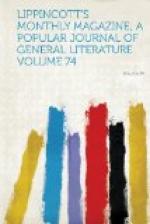at Lucerne, made to commemorate the Swiss guards at
Paris who fell in defending the Tuileries, August
10, 1792, is known to every tourist: it is altogether
conventional, but it is not commonplace. “Never
having seen a live lion,” says his biographer,
“he went to antique statues for inspiration:”
he thus, at two or three removes from Nature, secured
a grand, monumental conception, fully charged with
human intelligence. The colossi of Christ and
his Twelve, now to be seen with the artist’s
other works at Copenhagen, and formerly exhibited at
the World’s Fair in New York, are imposing and
classical, while they perhaps show the absence of
the Christian idea noted in his other clerical subjects.
Thorvaldsen, born a Lutheran, was a spectator in Rome
of bigotry and skepticism, and took refuge in artistic
impartiality. A friend once observing that his
want of religious faith must make it difficult to
express Christian ideas in his works, “If I were
altogether an unbeliever,” he replied, “why
should that give me any trouble? Have I not represented
pagan divinities?—still, I don’t believe
in them.” The life of this artist was one
of consummate worldly success; the kings of Bavaria
and Denmark were the personal friends of the unlettered
son of the ship-carver, as were Horace Vernet, Walter
Scott, Andersen, and Mendelssohn; his casket of decorations
was the amusement of his lady visitors; and his invitations
were so constant that he could not always remember
the name of his host: he was at once parsimonious
and charitable, cheerful and melancholy. His artistic
influence was very strong, exhibiting itself in the
style of Tenerani, Galli, Rauch, Drake and Bissen.
The life of him by Plon is methodical and complete,
and the American version is illustrated by thirty-five
careful engravings printed in Paris and gummed upon
the sheets.
Expiation. By Mrs. Julia
C.R. Dorr, author of “Sibyl
Huntington,” etc.
Philadelphia: J.B. Lippincott & Co.
Expiation is an interesting American story,
with a background of lonely woods that protect the
rustic privacy of Altona, and a list of characters
that combine city culture and country eccentricity.
Patsy, the grim and self-sacrificing “help,”
who observes drily of a statue representing Eve with
the apple that “some things is decent and some
things ain’t,” is the best delineation
in it, but the style is always lively, always feminine
and pure, and the conception of the high-bred, aristocratic
family, come to bury their mistakes and miseries in
a forest seclusion, would have been thought worthy
of being worked up by Emily Bronte. The catastrophe,
where a dumb nun turns out to be a lost wife given
over to the undertakers in a state of catalepsy, is
perhaps not quite new, but it is striking and vigorously
told, and her union at last with her husband’s
sons and the girlish bride of one of them is very
touching. The novel is full of local American
color, and entices the attention from the reader’s
first plunge to the end.




